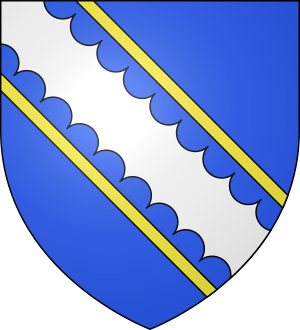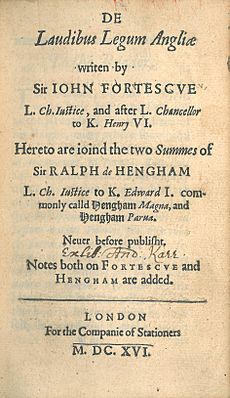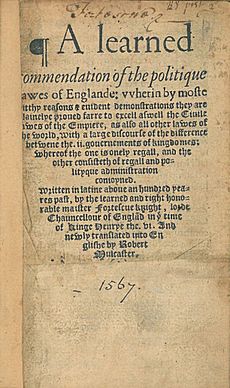John Fortescue (judge) facts for kids
Quick facts for kids
Sir
John Fortescue
|
|
|---|---|
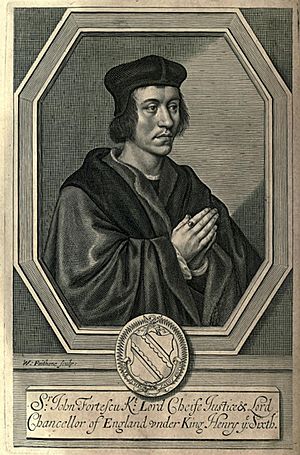
A portrait of Fortescue by William Faithorne published in 1663 inscribed "Sr John Fortescu Kt Lord Cheife Justice & Lord Chancellor of England vnder King Henry ye Sixth"
|
|
| Chief Justice of the King's Bench | |
| In office 25 January 1442 – Easter term 1460 |
|
| Appointed by | Henry VI |
| Preceded by | John Hody |
| Succeeded by | John Markham |
| Personal details | |
| Born | c. 1394 Norris, North Huish, Devon, England |
| Died | 1479 (aged 84–85) |
| Resting place | St. Eadburgha’s Church, Ebrington, Gloucestershire, England 52°3′28.98″N 1°44′0.92″W / 52.0580500°N 1.7335889°W |
| Alma mater | Exeter College, Oxford |
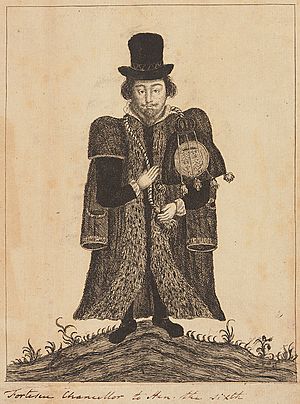
Sir John Fortescue (around 1394 – December 1479) was a very important English judge and writer. He lived in Ebrington, Gloucestershire. He became the Chief Justice of the King's Bench, which is a top legal job in England. He also wrote a famous book called De Laudibus Legum Angliae, which means Commendation of the Laws of England. This book was about English law and was published after he died, around 1543.
During the time of King Henry VI, Fortescue was a governor at Lincoln's Inn, a place where lawyers are trained. He was also a Member of Parliament (MP) from 1421 to 1437. He became one of the King's Serjeants (a type of senior lawyer) in 1441. Then, on January 25, 1442, he was made Chief Justice of the King's Bench, a role he held until 1460.
During the Wars of the Roses, a big fight for the English throne, King Henry VI lost his power in 1461. Edward IV became the new king. Sir John Fortescue stayed loyal to Henry VI. Because of this, he was accused of treason. He is thought to have been given the title of Lord Chancellor by Henry while Henry was in exile. Fortescue went with Queen Margaret of Anjou and her court to Europe from 1463 to 1471. During this time, he wrote De Laudibus Legum Angliae to teach the young Prince Edward. After Henry VI's side lost the war, Fortescue made peace with King Edward IV. Edward then removed the treason charge in October 1471.
Contents
Who Was John Fortescue?
John Fortescue was born around 1397. He was the second son of a lawyer named John Fortescue and his first wife, Clarice. His older brother was Henry Fortescue. The Fortescue family's earliest known home was Whympston, in a place called Modbury in Devon.
His Path to a Legal Career
John Fortescue studied at Exeter College, Oxford. Many young men from important families in Devon went to this college. He was chosen to be a Member of Parliament (MP) for different areas: Tavistock (from 1421 to 1425), Totnes (in 1426 and 1432), Plympton Erle (in 1429), and Wiltshire (in 1437).
During King Henry VI's rule, Fortescue was chosen three times to be a governor at Lincoln's Inn. This was an important legal school. In 1441, he became one of the King's Serjeants, a special type of lawyer who worked for the King. On January 25, 1442, he was made the Chief Justice of the King's Bench. This was a very high position in the legal system. He kept this job until 1460. People said Fortescue was a wise, serious, and honest judge, and the King liked him very much.
He stayed loyal to King Henry VI. When Henry VI was removed from power by Edward IV, Fortescue was accused of treason. When Henry VI fled to Scotland, he supposedly made Fortescue the Lord Chancellor. Fortescue even called himself this on the cover of his book. However, because King Henry didn't have the official Great Seal of England while in exile, some people think this title was just for show and didn't have real power.
In 1463, Fortescue went with Queen Margaret and her court when they had to leave England and live in Europe. They came back to England in 1471. While they were away, he wrote his famous book, De Laudibus Legum Angliae. He wrote it to teach the young Prince Edward. In this book, he wrote a very famous idea: "one would much rather that twenty guilty persons should escape the punishment of death, than that one innocent person should be condemned, and suffer capitally." This means it's better for many guilty people to go free than for one innocent person to be wrongly punished. After Henry VI's side lost the war, Fortescue accepted King Edward IV as the ruler. Edward IV then removed the treason charge against him on October 13, 1471.
His Family Life
By 1423, John Fortescue was married to Elizabeth Bright. She was the daughter of Robert Bright from Devon. Sadly, she died in 1426 without having any children. By 1436, he married Isabella James. She owned land in Somerset and Wiltshire. They had three children:
- Martin Fortescue, born around 1430, who married Elizabeth Denzill in 1454.
- Elizabeth Fortescue, who married Edward Whalesborough in 1455.
- Maud Fortescue, who married Robert Corbet in 1456.
His Death and Burial Place
We don't know the exact day John Fortescue died, but it was probably just before December 18, 1479. He was buried in the Church of St Eadburga, Ebrington in Gloucestershire. This was the area he had bought. His family later took the name of this place for their title, Viscount Ebrington. Inside the church, there is a stone statue of John Fortescue. It shows him wearing his judge's robes. In 1677, one of his descendants, Robert Fortescue, put up a special monument with a Latin message about him. Later, in 1765 and 1861, the monument was repaired by other family members.

Why He Is Remembered
John Fortescue's ideas about England's government were very important. He described it as a "political and regal kingdom," meaning it had both a king and laws that limited his power. This idea greatly influenced how people thought about the British government for a long time.
People who study literature are also interested in Fortescue because he helped develop English writing. He was also a writer who supported the Lancastrian side during the Wars of the Roses. Today, law students at Exeter College, Oxford can join the John Fortescue Society, named after him.
His Important Writings
Fortescue wrote his most important books while he was in Scotland and France, between 1463 and 1471. This was when the Lancastrian party was in exile. His main works include:
- Opusculum de natura legis naturæ et de ejus censura in successione regnorum suprema (around 1463): This book was about natural law and how kings should inherit their power.
- De laudibus legum Angliæ (1468–1471): This famous book praised the laws of England. It was first printed around 1543.
- The Difference between an Absolute and Limited Monarchy (published in 1714) or The Governance of England (published in 1885): This book, written around 1471, talked about the differences between a king who has total power and a king whose power is limited by laws.
These books were the first to really discuss the ideas behind England's common law and its government. Fortescue's works were read by important thinkers in England even before they were printed. De laudibus legum Angliæ was printed many times under different names.
The Difference between an Absolute and Limited Monarchy was published in 1714 by one of his descendants. A newer version of this book, called The Governance of England, was published in 1885.
Fortescue also wrote several shorter pieces about the political fights during the Wars of the Roses. These included pamphlets like The Title of Edward, Earl of March and Defence of the Rights of the House of Lancaster. All of these smaller writings can be found in The Works of Sir John Fortescue, which was published in 1869.


